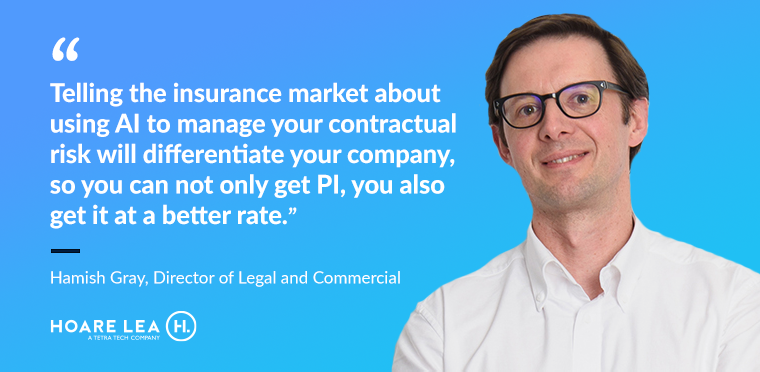With spiralling insurance costs impacting profits and in some cases the viability of companies in the engineering and construction sector, it’s time for a new way to manage contractual risk.
Feeling the PI squeeze in construction
The aftermath of the Grenfell Tower tragedy continues to be felt in the construction sector. Risk and liability remain high on the agenda, especially when it comes to professional indemnity insurance (PI). Nervous insurers are asking significantly more questions of the engineering and architectural contractors who are employed as third-parties on construction projects.
This safety-first approach means that the pool of available insurance has shrunk, leading to a tighter, more competitive market that has seen astronomical spikes in premiums.
The Construction Leadership Council recently released the results of its second annual survey, and the findings make for some uncomfortable reading.
- Nearly one in five (17%) respondents are paying more than 5% of their turnover for their annual premium.
- One in twenty (5%) are paying more than 10% of their turnover for their premium.
Let’s consider these numbers in practical terms. Balfour Beatty reported underlying revenue of £8.28 billion in 2021 with profits of £87 million. As a guess, let’s assume that with purchasing power they pay 2% of revenue for insurance. That works out as an outlay of about £165 million. A single percentage increase in insurance costs amounts to just shy of £83 million – a figure not far off its reported profits of £87 million for 2021.
There are plenty of hypotheticals in this example, but the point is that for a large, established firm, the cost of insurance is almost double the size of reported profits. And any hikes in insurance can run into tens of millions pounds that would otherwise be profit for shareholders.
Think that’s bad? Smaller companies have it worse
The squeeze on PI is impacting smaller firms’ ability to even get the insurance they need. Never mind inflated prices, some simply can’t get cover at any price. According to the survey conducted by the Construction Leadership Council:
- Nearly a quarter (22%) of respondents are still unable to buy the cover they want or need.
- A third (33%) of respondents have been declined insurance by three insurers or more.

What’s a loss of profits for the big firms is a much bigger, more existential problem for smaller businesses. An inability to get insurance, or having to pay over the odds for cover, can be simply unsustainable for their entire operations. Businesses are going under or having to remodel their business structure.
- A quarter (24%) of respondents have lost jobs as a result of inadequate PI insurance.
- Three out of ten respondents (30%) have changed the nature of their work due to inadequate PI.
With insurance costs spiralling – or adequate cover simply not being offered – what can be done to turn this situation around?
The appeal of better contractual risk management
If you live in an area where there’s a spate of car thefts, you may find your insurance is lowered if you install a retractable bollard on your driveway. Similarly, you’re far more likely to see your premiums reduced if you take an advanced driving course. The insurer has demonstrable proof that you’re serious about reducing risk and have proactively taken recommended steps, and you get rewarded as a result.
The construction industry works on a similar premise. Better contractual risk management makes your business and your projects more attractive to insurers. When insurance providers have greater confidence in your contractual risk management, you’re more likely to get more favourable terms on your insurance.
Appointment letters and contractual risk
So what does contractual risk look like for contractors in the construction sector? To answer this question we need to look at how appointment letters are processed. Appointment letters are service agreements that capture what is and isn’t in scope for a project, and where the contractor has liability and obligations.
Currently, the review of appointment letters is often an additional service provided by insurers. This helps the contractor to outsource the appointments reviews, and the insurer will deliver the service as a way of reducing contractual risk for the contractor.
If managed in-house by the contractor, it will typically be a manual process. The legal team will read the agreement and identify where possible risk lies, and which terms are and are not acceptable from a commercial perspective.
These risks will be documented and shared internally, and a redlined agreement will be sent back to the counterparty for their review and response.
How can this process be improved to demonstrate better risk management to insurers?
Demonstrating better contractual risk management
Our contacts and colleagues in construction are telling us that adopting a modern, technology-led approach to contractual risk management is leading to better terms from insurers.

Hamish Gray, Director of Legal and Commercial at Hoare Lea, says: “Telling the insurance market about using AI to manage your contractual risk will differentiate your company, so you can not only get PI, you also get it at a better rate.”
As advances are made in AI-based technology, so trust and confidence in its capabilities are increasing. And this is delivering a measurable difference in profit margins.
For example, using technology to automate the agreement review and the checklist creation is becoming best-practice among industry leaders. The time-saving benefits alone are enough to warrant investment, with automated reviews up to 66% faster.
But this only tells a fraction of the story.
Consider the energy and time it takes to decipher the variant of legalese used in each appointment letter. It takes focus away from the important matters that should be the core focus. Technology can be trained to see beyond the specific choice of words and decipher the meaning of each clause, telling you what you need to know.
Automating the checklist also saves the hassle of manually creating an issues list and communicating it with colleagues and counterparties.
And by digitising appointment letters, you create digital assets that can be leveraged for contract analytics later on. With all current and historical contractual data in an easily accessible structured format, you can identify trends and review responses to similar agreements in the past to see how you acted and ensure a consistent approach to risk.
The future will be defined by AI-assisted legal advice
It’s worth remembering that AI will never replace lawyers. What it will do is help any professional who needs to review and respond to a draft contract to achieve their core objectives with greater speed and less hassle.
Better contractual risk management for construction appointment letters is a great example of this in action. It enables lawyers to have a direct impact on the business – reducing insurance premiums, turning losses into profits, and being the catalyst for business growth. It’s not an overstatement to say that it could even be the difference between remaining in business or sinking without trace.




